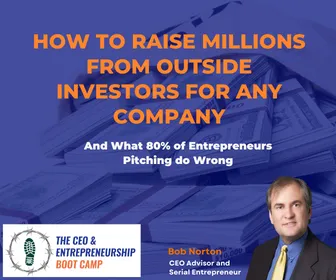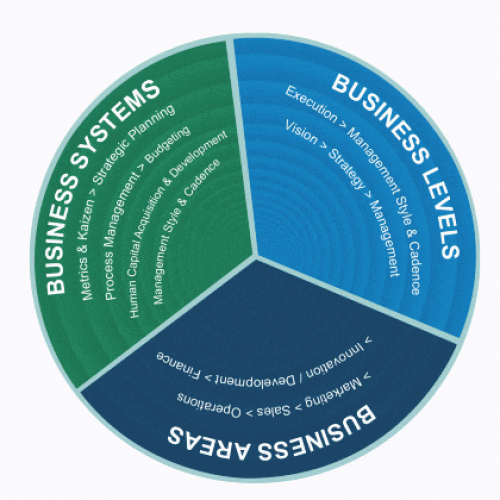There is a lot of talk about creating and maintaining a vision, especially as part of a CEO’s job. In my opinion, ‘vision’ is a term that is both greatly overused and largely misunderstood. Many people consider vision to be an all-encompassing view of the product or service, while others expand its meaning to include the entire market, and still others believe the term encompasses far more.
What is “vision”? Why do you need one? How Do You Use It? How Do You Know It Is Complete?
Having been personally responsible for a corporation’s vision for many years, I believe it covers more than what most people think. So, what follows is my definition of vision, and I do not understate the case when I say that, with few exceptions, the lack of a strong vision puts you at a distinct competitive disadvantage.
“Genius is one percent inspiration and ninety-nine percent perspiration.” So is developing a vision.
To begin with, I believe a vision must encompass everything about the business. This includes everything from things as high-level and broad as the organizational chart, right down to details like basic product functionality. It also includes both the strategic and tactical levels of every discipline required to run the business. A vision must include both these levels for every function vis-à-vis finance, sales, marketing, operations, and product development. Each variable must be imagined over time as a series because many will change rapidly. Does this sound like a mind-blowing exercise? Yes, it does! Thankfully, since our brains are wired to think visually and are the most powerful computers on earth, this task is well within most people’s intellectual capacity if they have the experience and information.
The biggest issue is that most people don’t have all the needed information or expertise to understand and design these business models. This is real work, not magic, luck, or the flash of insight that may have been the genesis of a product’s unique abilities. As Thomas Edison says, “Genius is one percent inspiration and ninety-nine percent perspiration.” The exercise of writing a business plan generally fills in much of the vision and is worth the effort even if you throw the plan in the trash when you are done. It can allow the merger of different skill sets to happen. However, this is not the same as having the experience in one’s head, which forces greater discipline and integration and allows the model to be “run” in the visionary’s head.
“Teamwork is the ability to work together toward a common vision. The ability to direct individual accomplishments towards organizational objectives. It is the fuel that allows common people to attain uncommon results.”
Why, you ask, must a vision be so elaborate? The company to live by. This helps ensure consistency across departmental goals and helps eliminate other major factors that can split a business into fractional pieces, such as two departments going after different objectives and effectively dividing your resources across these objectives, or even markets.
“It is the function of creative man to perceive and to connect the seemingly unconnected.” — William Plomer
What are the Other Slices of the Vision Pie?
Well, each major function (or department) that is required to create a business makes up a slice of the pie. For example, a typical company would include the following vision slices:
1) Sales: target customer, pricing, sales and distribution models, strategies, and tactics.
2) Marketing: All sales-lead generation functions and activities designed to educate consumers and position the company, competitive intelligence, and market positioning strategy.
3) Finance: All sources and uses of capital, all systems to manage and project it, all accounting functions to track expenses and revenues.
4) Product Development (R & D): idea generation, architecture, design, development, testing, and quality assurance. Each of these is a process that evolves over time, not just an idea.
5) Customer Service: The service model (i.e., team or individual), CRM, or Operations…
“To be successful, you’ve got to have a dream, a vision, a burning passion, a magnificent obsession.
“This dream, goal, the obsession has to become your prime motivator.
“It takes enthusiasm, commitment, pride, a willingness to work hard, a willingness to go the extra mile, a willingness to do whatever has to be done in order to get the job done.”
— Jeffrey J. Mayer
{Author of Success is a Journey}
Many young companies have a good product vision that stems from the technical founders, who often see a need and understand how to fill it. However, most of these founders lack experience in the other “business” areas and needed to turn a “product-only vision” into a viable business. They see the market need and the solution but require help to build an organization that can deliver the product to the market, which is a much more complex endeavor involving many disciplines. Getting any one of these slices wrong is often fatal to a company.
Well, you get the point. There are usually five major slices, with two parts to each (the strategic and tactical levels). Vision is everything needed to make the company work across all these functions. And remember that it must also be a series of these snapshots over time for planning and growth purposes, as it must evolve slowly, not make big leaps. I would recommend corporate snapshots for today, one year out, two years out, three years out, and even five years out. The further out your vision is, the less detail you will need to have because many things will change over time and because you only need to understand and plan the details for each year.
Wayne Gretsy, when asked why he was such a superior hockey player, responded, “Because I go where the puck will be, not where it is.”
Of course, the financial plan slice should include each month or quarter in great detail for years one and two, but it is generally a total waste of time to do more than annual numbers for years three and beyond, as experience and circumstances will modify these for sure. Sometimes financial people will run numbers over and over again in great detail for five years out. This is basically just plain silly and a waste of effort and time at a certain point. I call it being “perfectly incorrect.”. All these models will be very wrong, guaranteed; the idea is to iterate them closer and closer to reality as you gain more data and experience. The goal of a financial model is to simulate, project, and plan, and that simulation must be updated as you go. If you have to adjust your pricing by even 15%, then every previous version of that model is instantly obsolete. This is just another slice that focuses on financial specifics and tries to show that the business can be profitable at some point in the future.
Every great accomplishment starts as only a vision in a single mind, which then spreads to others through passionate communication until many are working towards a single, complex goal.
We Never Plan To Fail; We Only Fail To Plan.
So how do you design, develop, and communicate such a complex beast? Well, it could be one of the most challenging exercises in the gray matter of your cerebral cortex. We all have the exceptional capacity to think visually and generally; that is how a vision is best evolved. A framework of experience is needed in each discipline. Without it, you cannot really validate the model without a very expensive real-life trial and error. Most entrepreneurs make the mistake of learning it on their own through expensive trial and error when they could save hundreds of thousands of dollars, even millions, by involving someone with the right experience. Many visions are “unexecutable.”. This means that they are doomed to fail from day one because of something the entrepreneur does not yet know or has not recognized due to lack of experience. It is easy to visualize something that may never work. Let us face it, venture capitalists, who are mainly smart, educated professionals, do it every day by investing the bulk of their dollars (60% to 90%) in businesses that will never work! The fact is, there are way too many variables for anyone to really know something will work well unless they have experience in all the required disciplines.
Any Vision Must Evolve With Time
Now let’s think about a series of these vision pies over time to create a stack of them with a pie for each of the following three to five years (see below). With each additional year, the vision will contain less detail, and the current probability of being right diminishes greatly. This is what I call the “Vision Cone.”.
“Genius is the ability to reduce the complicated to the simple.” — C. W. Ceran
Every vision needs actual validation in the real world for virtually all its elements. Certainly, the ones that have not been done exactly that way before and have not had great success are a significant risk and deserve special testing in ways that will not disrupt the business if they fail. This testing is known as actively managing the risks, something any CEO should be doing. I have a separate system on this later.
Most venture capitalists insist on a “seasoned” CEO at the helm of a new company—someone who, based on many years of experience, can actually run these “vision simulations” or business models in their heads. Many things can cause a business to fail. Even small things that fail to work because of typical personality types in certain jobs can delay or prevent a business from being successful. Only a significant amount of real-world experience can reduce this risk.
Learn more about our Growth and Scaling (GSP) Certification program for managers by clicking here
How Do You Practically Implement a Vision?
A personal vision is much simpler and very different from a corporate vision. Corporate visions require many moving parts, many people, and many areas of expertise.
Developing a Personal Vision:
- Vision: What you want most for your life (a dream made real)
- Mission statement: A description of how you attain your vision
- Goals
- A definitive statement of exactly what you desire
- Written in the present tense
- Measurable (i.e., there is an objective way to determine you have met it)
Unfortunately, it is impractical to expect every department head to understand the entire vision. As a matter of fact, it is virtually impossible because it is likely that they do not understand the other disciplines well enough or have enough access to information. However, a good CEO makes sure each department head has a complete understanding of their slice of the vision and how it is phased in properly, over time, with the other departments. This can sometimes be done by creating interlocking goals or end dates that are one or more quarters away. For example, customer service will hire a new manager when sales hit 20 new customers.
A vision is important because it is what unifies all the resources on a single “objective,” which ultimately is a single position in the marketplace. This position must include virtually all product factors recognizable by a sophisticated buyer in the market, as well as all the variables that make up the complex structure of the organization to create, deliver, and service that product.
Diagram: The Vision Cone
Each day, a CEO will use the vision to measure decisions against; each day the VP of Engineering should be making decisions consistent with his or her slice of the vision, and each day all key management players should be doing the same. If you have someone measuring their daily decisions against their modus operandi at a former company, or just their favorite way of doing things, then odds are you have a personnel problem that needs to be addressed. This is a common problem because human nature dictates that we do it the way we always have (the easiest way), as opposed to really thinking about how this situation may be different.
An important thing to remember is that without the right experience, from every discipline in the room, and all the right market research, it is impossible to define a real vision.
Most companies, in fact, do not have a full vision or anything near it, though they will claim they do.
In my experience, it takes a new CEO four to eight weeks of full-time work to develop a complete vision for the company. This will vary greatly, depending on the complexity of the company, market, and product involved. Vision development must include time spent with customers, time spent with all key employees, and lots of research to validate the theories that are being used to make decisions.
For a free video consultation call on what your company and team need to scale better, click here
How Can a Vision Be Communicated?
One of the CEO’s most important roles is to communicate the vision to management and employees and yet be open enough to the possibly superior experience of others in a specific area to modify it as they learn more. We can debate how much of this vision investors and customers need to know, as this will vary greatly from time to time and by industry and competitive environment, but the employees need to understand those parts of the vision that affect their jobs. At a minimum, they need to know at least enough to make day-to-day decisions that are consistent with that vision.
“Things may come to those who wait, but only the things left by those who hustle.” — Abraham Lincoln
When a CEO actually communicates his vision, it must be tuned to the particular audience and their ability to understand that vision. The broader the audience, the more simply the vision must be presented. The simplest example is the mission statement, or “elevator pitch.”. The mission statement is simply a vision that is distilled down to the simplest and most understandable end result or objective. For example:
“Widgets Software will be the best software component maker for software development tools used in the development of video-on-demand products.”
This is a simple statement! It is easy for anyone in any department to understand, but it obviously implies a huge number of moving parts in many departments and disciplines. It clearly communicates that Widgets Software is NOT in the media content or entertainment business, nor the application business, but in the development tool business. These would all be very different business models, needing very different organizations and visions. It should prevent people from investing resources in things that might make more sense for these other business models.
Our work is the presentation of our capabilities.
In high-level staff meetings where all senior management is present, this vision can be explained in much more detail because you can assume the audience knows a lot more about the basis for the vision and has more experience. During one-on-one meetings with experts in certain areas, you can drill down on this vision to great detail, talking in shorthand and using diagrams about specific attributes as they evolve over time (i.e., people, capital budgets, other resources).
Commitment
Until one is committed, there is hesitancy, the chance to draw back, and always ineffectiveness. Concerning all acts of initiative and creation, there is one elementary truth, the ignorance of which kills countless ideas and splendid plans: that the moment one definitely commits oneself, then providence moves too. All sorts of things occur to help one that would never otherwise have occurred. A whole stream of events issues from the decision, raising in one’s favor all manner of unforeseen incidents, meetings, and material assistance that no man could have dreamed would have come his way. Whatever you can do or dream, you can begin it. Boldness has genius, power, and magic in it. Begin it now!
In my opinion, the greater the ability the CEO must develop this internal vision in his own mind, the greater the chance of success for the business. However, quality teams can develop a vision too; it just takes a lot more work and discipline but is often necessary for larger companies. The vision essentially creates a philosophy for the business to run by, which helps to ensure minimum waste, maximum impact, and convergence on the goal (a market position) by all the troops at the same time. Having them all arrive at the goal at different times is a problem.
A well-developed vision is a combination of lots of experience, thought, research, and understanding of customer needs, all unified in one person’s head. This is then run as a model against a backdrop of real-world management and operations experience to verify, as much as is possible, what can really work. Hopefully, this can all be done at a cost that is some margin above what customers are willing to pay to make the business economically viable.
Dream no small dreams, for they have no power to move the hearts of men.
In conclusion, a vision is the design of everything needed for the business to work, combined with the experience to know that it can really work that way in the real world. A vision is essential—a mental simulation. So, a vision is actually a very complex model that can be run in someone’s head, which takes into account all the major business disciplines and thousands of real-world practical factors that are only available through long experience. I think this is a fairly good working and practical definition of a vision, and there is no doubt that having one can greatly increase your chances of success.















